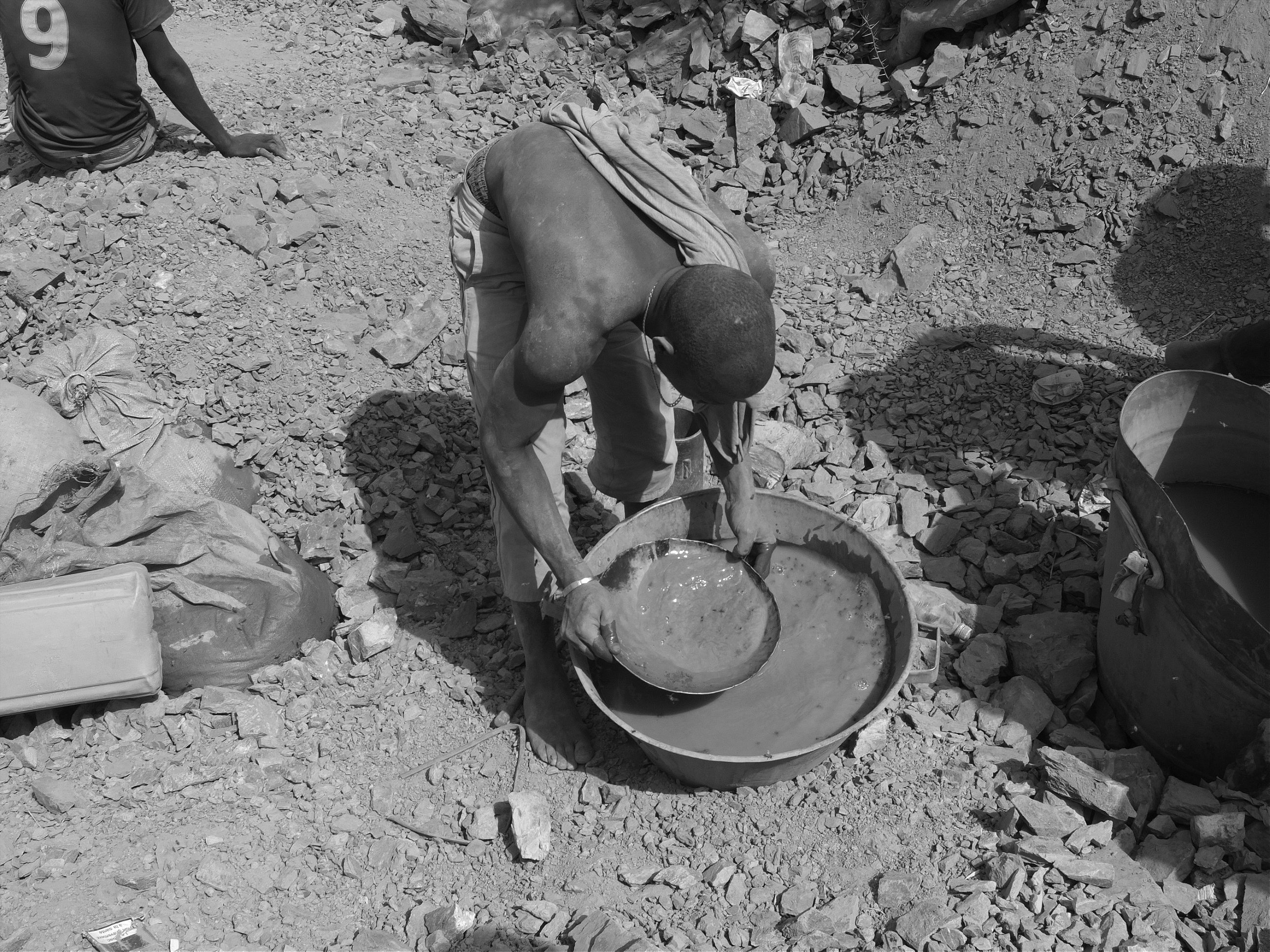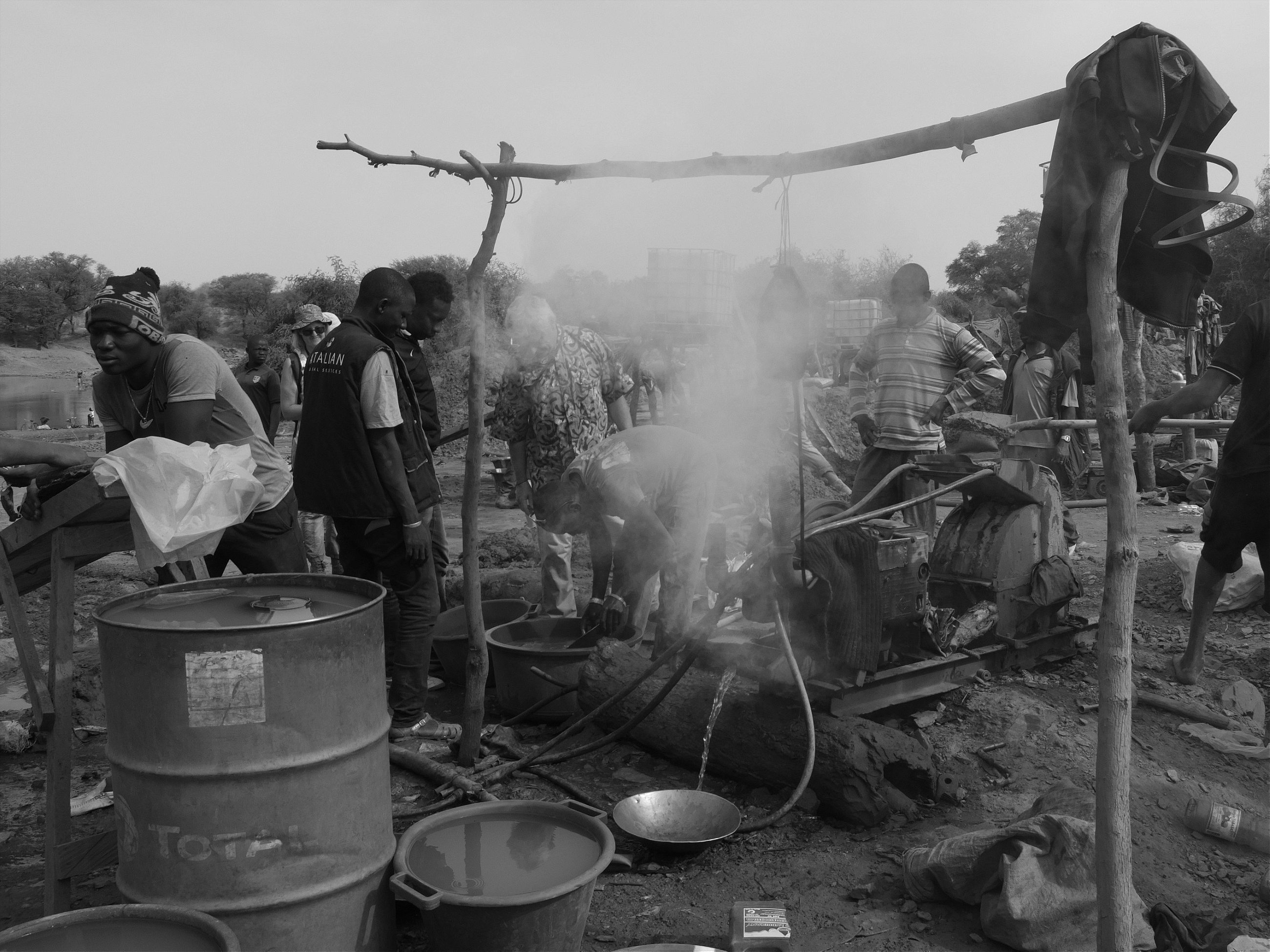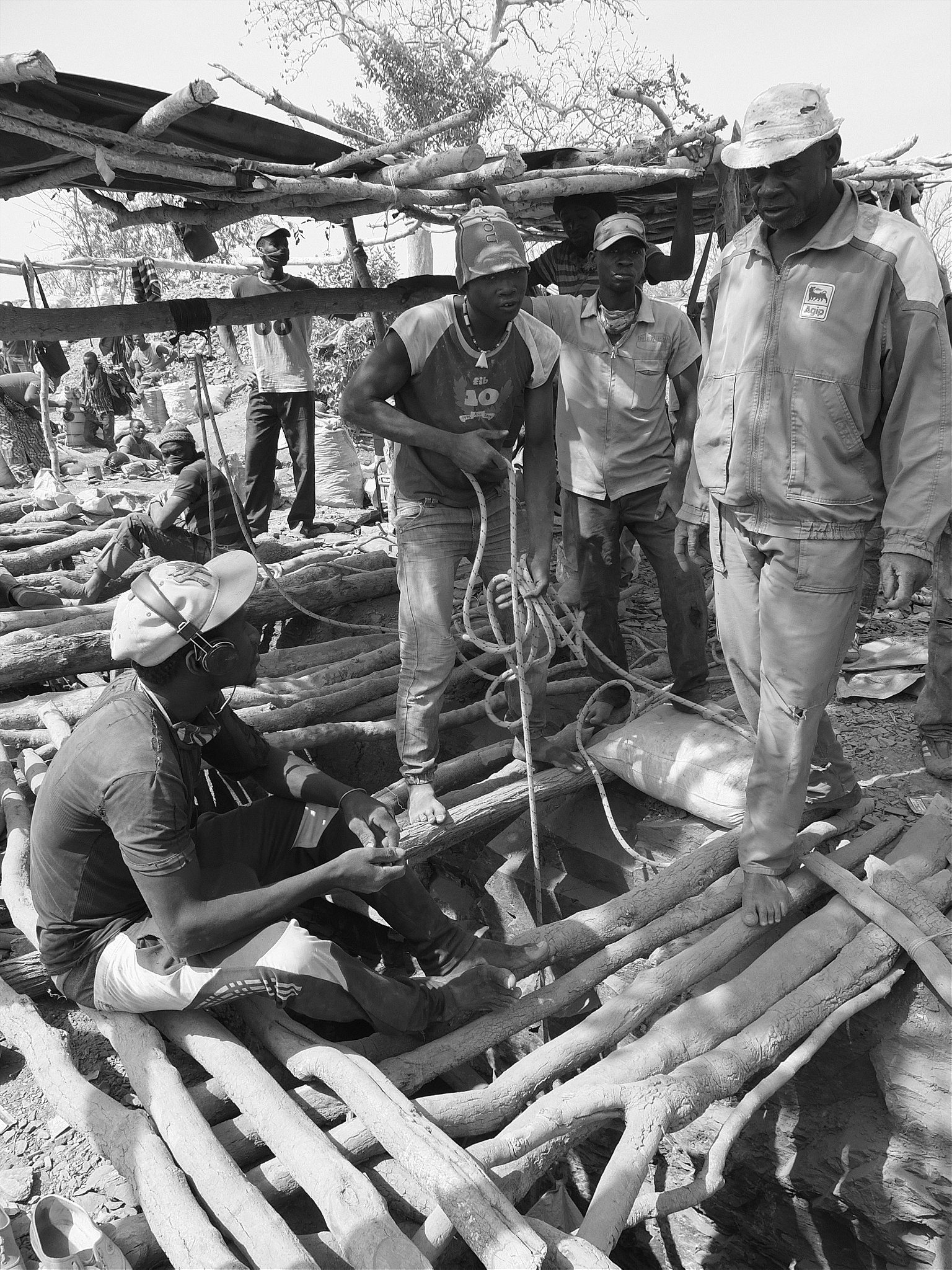In eastern Senegal, an unexpected gold rush gives a shot at wealth for those willing to take the risk.
We stand as a group on the banks of the Falémé River, in eastern Senegal, waiting our turn to ford the river on foot. From the far side, the stutter and grind of Chinese-made ore-crushing machines drifts across like distant machine-gun fire as we wade knee-deep through the silted water and scramble up the muddy bank. Groups of three or four people, who have come to the river to wash their clothes or fetch water, watch incredulously as we make our way in a procession up the slope, crossing a gulley awash with brown water and crushed Coca-Cola cans.
We are just a few of the hundreds who have made their way here from across West Africa, though as a group of archaeologists working about half an hour upstream, we have not come as far as most. Our guide, Ousmane, who works with us at the archeological site, comes from the nearby village of Toumboura, which has been at the heart of the gold rush that began here in early January. By the time we arrived in mid-January to begin excavations at a large medieval site in the area, as we have done every January for the last five years, there were very few young people left in Toumboura. Only Ousmane and a few others remained to hold down the fort. All the younger men and women with whom we had worked in previous years, including Ousmane’s brother, had left town.
“Sambayaya,” he said with a smile, when we enquired where they had gone. “They’ve gone to get rich.” He laughed when we expressed an interest in visiting the mines in order to witness the fever that has gripped the valley, of which we are often temporary residents. “You’re looking to get rich, too?” he asked.
For the first time of many, we heard the story of how the gold mines had been discovered. Towards the end of December, a shepherd from the village of Sambayaya, across the Falémé river and about 12 miles downstream from Toumboura, had gone for a walk in the bush. When he came back that afternoon, he produced a large nodule of gold he had found, which he sold a few days later for 600,000 CFA francs (around $990 U.S. dollars). Unable now to keep word from spreading, he was joined on his next foray by dozens of locals from the surrounding villages.
A full-scale mining operation, built on human strength and home-made pick-axes
Since then, Ousmane tells us, the region’s population has swollen, with a vast tent city of some 7,000 people congregating here at Sambayaya, which formerly had a population of 200. Migrants from Senegal, Mali, Guinea-Bissau, Burkina Faso, Gambia, and the Ivory Coast have increased the population by more than 30 times, turning a small fishing village into the largest town for some 25 miles. In a little under two months, he says, a full-scale mining operation has been launched, built on the most basic and ancient of techniques: human strength and home-made pick-axes.
As we crest the slope, the enormity of the operations become evident. The rapid fire of the ore-crushing machines and the hot, dry smell of earth are overwhelming. Sitting at the top of the terrace, hunched over the ore-crushers, are a dozen small groups of young men working in feverish orchestration.
We wander among the piles of machinery as Ousmane quietly narrates behind us. Here is where large blocks of ore are pummeled into a fine powder. There, a gold-panner is at work. Reaching down into a slush-filled pit with a steel pan, he scoops up a few cups of water and gently rolls it around inside. Skilfully, at each turn of his wrist, he allows the excess water to spill over the lip of the pan, leaving the heavy sediments to accumulate in the bottom. When there is only a small pool of water left in the pan, he allows it to circulate in the bottom with the sediments, using his free hand to sift through the mud and sand until he has found what he is looking for. Glinting in the silt were two small specks of gold dust.

The mine at Sambayaya is one of numerous artisanal—or small-scale—gold mining operations in eastern Senegal. One study has estimated that there are some 9 million artisanal gold miners in sub-Saharan Africa alone, in addition to the 54 million who depend on the sector in some form for their livelihood. In Senegal, this sort of mining has been prominent in particular within the last 50 years, with the discovery of a concentration of rich seams along the Falémé River valley.
‘Artisanal’ is the industry term given to such an operation. What it translates to is the near-complete absence of any government control or regulation. The young men operating these ore-breaking machines were not employed by an industrial mining company. They, like thousands of others, had heard of the site through informal networks and made it here on their own in the hope of finding enough work to supplement their regular incomes back home. The average daily wage of between $4-$7 USD at the mines is well above the wage of a field laborer, and a five-gram gold nugget retails here at about 100,000 CFA, or about $160 USD.
From the riverside industrial quarter, we enter the sprawling shanty town of wooden scaffolding draped with fabric and topped by corrugated iron lids. While some have left their jobs behind to come work at the mines, many have brought their trades with them. In one structure, two butchers flay a goat, adjacent to a man sitting in a car seat on the ground working on a stripped-down motorcycle. A barber in a swivel chair sits next to a poster listing the different cuts offered with their prices.
We follow the main sandy avenue as it curves around and up the hill, towards the village of Sambayaya itself, surrounded by a wooden palisade that gives the permanent residents an air of separation and the illusion of privacy. I find it hard to imagine that the village has adjusted well to the upheaval. Workers at our archaeological site often complain about the economic bubble that has formed in the region in the last few months due to the massive influx of workers and the flooding of the local market with gold money. Phone credit recharge cards recently worth 1000 CFA ($1.60 USD) now retail at around 1600 CFA ($2.60 USD), while basic foodstuffs such as rice and couscous have also seen wildly inflationary prices.
In addition, all of the new arrivals are serviced by the single well with potable water at Sambayaya that had previously served 200.
“Do the local people at Sambayaya benefit at all?” I ask Ousmane as we pass by the compound.
“Oh yes,” he says. “They all get their share through taxes.”
In the complete absence of the Senegalese state in rural life here, it is the village chiefs that are invested with absolute authority. They give permission for the gold mines to be dug, as well as allocate a mine site chief and assistants. They are the public face of local administration, keeping the law and, importantly, organizing and collecting taxes for the chief. Whether everyone is in fact getting their share is unclear.

In the southeast of the country, where there is the greatest concentration of artisanal mines, the government has made repeated attempts to formalize the process and divest local chiefs of their power. In the Kedougou region, a day’s drive south of here, this has been done through the introduction of mining permits and a miner card registration system.
In addition, there have been reports of the rapid closure of mines that have overlapped with commercial interests. However, without these small-scale mining operations, many ore deposits would go completely un-tapped. There is only one large industrial gold mine in Senegal, run by Canadian giant Teranga Gold Corporation at Sabodala, with a second due to open in June 2017. While multinationals such as Teranga may sit on a large deposit for a decade or so, smaller deposits, such as that at Sambayaya, present little commercial profitability on the industrial scale, but still contribute a significant proportion of Senegal’s gold production.
The surge in mining activity in the past decade also is far from being the region’s first gold rush. The famous gold fields of Bambuk, across the Falémé river towards the border with Mali, were a principal driver of the trans-Saharan caravan trade between the seventh and fifteenth centuries AD, and the reason behind the great wealth of the empires of Ghana and Mali. When the Malian king Mansa Musa arrived in Cairo during the Hajj of 1324-1325, he caused the European gold market to crash after he flooded it with one whole ton of the precious metal. Today, Africa still provides around one-fifth of the world’s mined gold.
“Who are you?” he asks, scowling
To get to the mines, we need to go several miles into the bush. We manage to find two tuk-tuk drivers willing to drive us to the site at a reasonable price, and set off along a braided mass of sandy tracks that loop and weave in and out of each other and the sparse patches of scrub. A steady flow of motorcycle traffic in each direction does the work of a shuttle service between the town and the mines, transporting both people and canvas sacks of roughly-hewn quartzite gold ore.
We arrive at a depot of wood and fabric stalls holding bags of ore ready to be taken to the river. At the entrance, we approach a group of motorcycle drivers to ask about entering. Although Ousmane guided us this far, we need another level of security clearance to get into the mines. Given the tensions that exist between such operations and government interests, they have their reasons to be wary of outsiders.
Soon, another man approaches our group and introduces himself as the municipal police officer.
“Who are you?” he asks, scowling. He stands with one shoulder slumped to the side, chewing on a root like a stick of bubblegum.
We explain our work as archeologists upriver and our interest in the mines. Satisfied, he bargains with the leader of our group, and after several minutes, we follow him into the mines.
The landscape is pockmarked with deep depressions between large mounds of soil that give the area the look of a bomb site. People move swiftly and orderly within a complicated web of territorial claims and rights of way. Vertical shafts are dug straight into the ground as people search for seams running off from the central vein. At the top of each hole, under the paltry shade of camouflage tarpaulins, groups of five or six young men sit awaiting their turn to go down. One man sits on a log straddling the hole, pulling up bags of ore as they are filled. Periodically, boys appear with glasses of sweet, brown tea, which the miners drink in a single gulp.

With the permission of one of the groups, I lean over a hole. From the bottom, I can hear the resonant sound of iron pick on rock. However, I can only barely make out the figure digging at the bottom, at a depth of around 30 feet. He is listening to an mp3 player and smiles up and waves before returning to his work.
When we reach the principal vein, the scale of the operation reveals itself. Here, instead of holes, a crevasse has opened up in the earth, six feet wide at the top and crookedly cleaving the site in two. Logs have been placed over the gap, which the policeman leads us over. I look down into the cavern but can’t see the bottom; I can only faintly hear the sound of picks.
“Twenty-five meters,” says a young guy sitting on a log, dangling his feet into the abyss. “Want to go down?”
I look back down, through the dust that rises up from the darkness. The vein has been picked clean by the miners, save for a few buttresses of stone left in place, apparently to stop the walls from collapsing in.
“No thanks,” I say.
“Are you sure?” he asks, flashing a gold canine. “You can earn a lot here at the mines. I earn four or five million CFA a day!”
Some miners have brought their families, who sit at the top of the embankment preparing food and washing clothes. An old woman sifts through the piles of rejected ore searching for rocks to put in her bag. Now, at the height of the day, the temperature is around 50 degrees Celsius—120 degrees Fahrenheit—and I start dripping sweat standing still. Meanwhile, the activity of the mine is at full capacity: miners shimmy up and down ropes; others lug out huge sacks of ore on their shoulders; boys crush ore with a metal pounder in crude iron crucibles on the side.
On our way out, we pass a group of backfilled shafts. Only a few hopeful teams remain digging in this area, far from the action and bustle of the principal vein. We ask Ousmane how many shafts had been sunk at the site, but he doesn’t know. Hundreds, he guesses. Some of the bigger mines down south are reported to have in excess of 600 shafts. As we clamber back into the tuk-tuks to head back to the river, we thank the policeman. He grunts and takes a 10,000 CFA note from our excavation director, then heads back.

We return to the archaeological site the next day to continue with our work. Although our team has been working in the area for the past five years, this is the first year we’ve had trouble finding workers due to the demand for labor at the mines. Although our project provides a relatively steady income for those who work with us, there is nonetheless a much lower chance of striking it rich in archaeology than in gold-mining, and thus many of our regular workers are not with us this year. Ousmane, however, is one of those who combine the two jobs in order to supplement his family’s income. He says, however, that the mining will not last long.
“When the rainy season comes, it will get tough,” he says. “Once the shafts fill with water, digging will be impossible.”
Even with water pumps, he tells me, it was likely that the mines would have to be temporarily closed until next year. Life may then return to normal at Sambayaya, at least until September and the end of the rains.